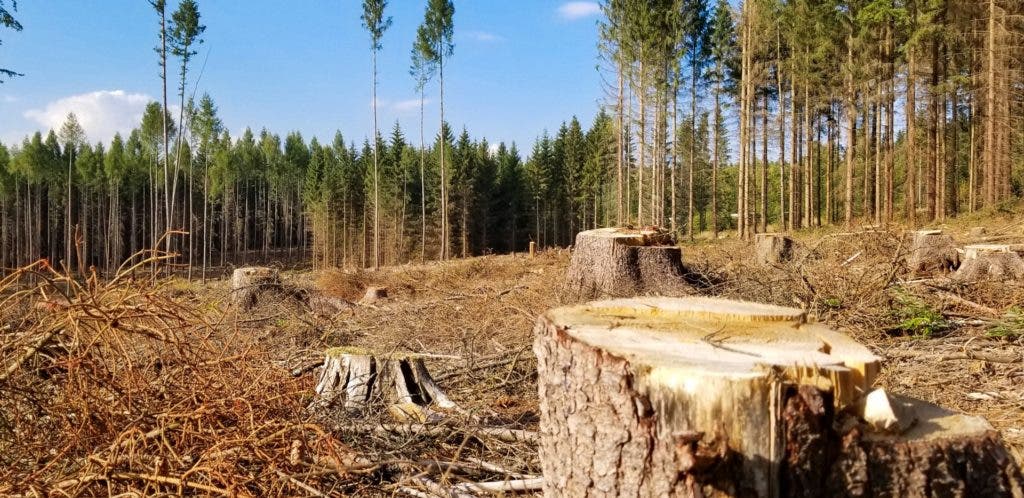It’s always a good idea to plant new trees after you cut some old ones. But that’s not exactly sustainable, a new analysis shows.

Forests still cover about 30% of the world’s land area, but their coverage are decreasing fast. Logging has always been an issue in modern times, with 1.3 million square kilometers of forest being lost between 1990 and 2016. Since humans have started cutting forests, 46% of trees have been felled, according to a 2015 study in the journal Nature. After a few encouraging signs, deforestation is once again on the rise.
Of course, forests have a natural replenishment rate, and humans also plant new tree areas. These efforts have put a dent in overall deforestation figures, although the net effect still heavily leans towards deforestation.
But even cutting trees and planting an equal amount is problematic, a new study suggests. Trees of recovering tropical forests were found to be different from those of old-growth forests. They had tougher leaves, with lower concentrations of the nutrients phosphorus and nitrogen — both essential for plant and tree growth. This is because constantly cutting trees and planting new ones depletes the soils of crucial nutrients, a new study concludes.
Essentially, multiple cycles of logging and replanting irreversibly remove phosphorus from the forest system — pushing the forest to its very limit.
“Old-growth tropical forests that have been the same for millions of years are now changing irreversibly due to repeated logging,” said Dr Tom Swinfield, a plant scientist at the University of Cambridge Conservation Research Institute, and first author of the paper published in the journal Global Change Biology.
Nutrients like phosphorus come from rocks, which are slowly incorporated into soil, from where they are absorbed by roots. When a tree is cut, these nutrients are lost. Swinfield and colleagues calculated that as much as 30% of the phosphorus in the soil is removed by repeated logging.
In order to do this, they used LIDAR measurements to create high-definition images of forests in north-eastern Borneo. This method uses high-precision laser scanners to take numerous measurements across the entire light spectrum to create a very detailed, 3D image of the forests. They then combined this data with nutrient measurements from 700 individual trees in the same forest — this allowed them to map the concentrations of nutrients in tree leaves over natural growth areas and areas with repeated logging.
The researchers found that differences from old-growth forest become more pronounced as logged forests grow larger over time, suggesting exacerbated phosphorus limitation as forests recover.
Each consecutive logging harvest reduces the levels of nutrients in the soil, the team adds. So far, trees seem to be coping, but they are being stressed more and more.
“We see that as the logged forests start recovering, they’re actually diverging from the old growth forests in terms of their leaf chemistry and possibly also species composition, as the amount of available nutrients goes down,” said Swinfield. “At the moment the trees can cope, but the fact that they’re changing indicates phosphorus levels in the soil are dropping. This could affect the speed at which forests recover from future disturbances.”
This matter has been severely understudied, the researchers also emphasize. Globally, we tend to think of forests as a zero-sum game: if we plant as much as we cut, then everything’s alright. But that’s not really the case.
Soils are often ignored in the conversation, and this can have devastating consequences for forest conservation. Also, it’s not just that the trees are there — not all trees are alike, and natural-growth, stress-free trees provide much better environmental services.
Lastly, while the study focused on Borneo, it is very likely that this issue affects forests worldwide.
“Phosphorus limitation is a really serious global issue: it’s one of the areas where humans are using a vital resource beyond sustainable levels,” concludes Professor David Coomes, Director of the University of Cambridge Conservation Research Institute, who led the project.
Journal Reference: Swinfield, T. et al: ‘Imaging spectroscopy reveals the effects of topography and logging on the leaf chemistry of tropical forest canopy trees.’ Global Change Biology, Dec 2019. DOI: 10.1111/GCB.14903


